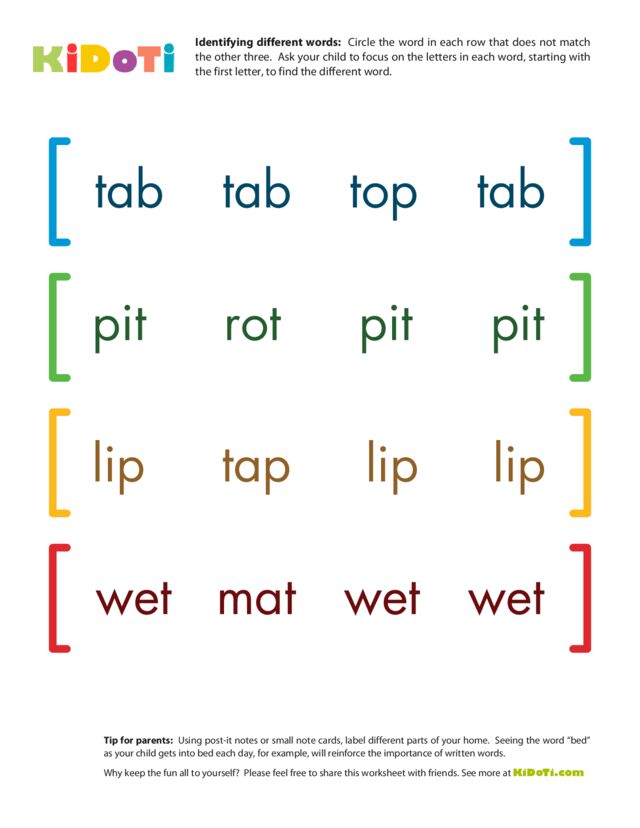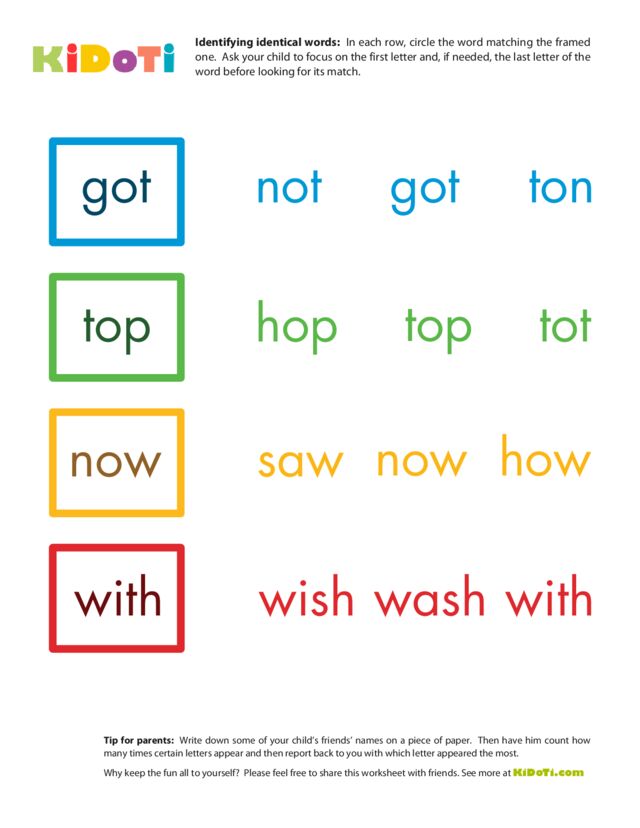Many words look alike and the substitution of one new letter into a word can create an entirely new word. As children learn to read and write, they must realize how each letter plays an important role in a word. The following worksheets will give older children important practice reading short words and identifying the words that are alike or different from the featured word in each row. Younger children who are not yet reading can simply look at each word carefully to identify the words that are alike or different from the featured word.
Identifying similar words is an important pre-reading skill
Reading requires children to look carefully at each word and recognize the letters that form that word. Before a child can even attempt to attach sounds to the letters in the word, he must accurately see the letters in the word. Also, children can become skillful in recognizing familiar groups of letters, called word families, to help them read more smoothly and fluently. But to do that successfully, they must be able to pay attention to the letters in the words they are attempting to read.
To hone these keen observation skills, children can practice looking at a series of words on a line and recognizing which words are the same and which words are different.
Tips for using these similar words worksheets
Some children have an easier time finding the word that is different from the other three in the line. Others seem to find it less challenging to look at the first word in a box at the start of the line and then look at each word until they finds the one that matches. Both of these worksheets present advanced challenges for children.
I recommend printing out one worksheet from each category to determine which style of word matching is easier for your child. Then allow him to complete all five worksheets in that group before moving to the other style of word matching worksheet.
If you find that your child is a bit overwhelmed by the number of words on the page, simply fold the paper to reveal one line at a time. Then tell your child that every letter of the word must be the same for the words to match.
On the worksheets that ask your child to find the word in the line that matches the first word in the box, ask your child to point to the word in the box and name each letter. Then suggest that he slowly move his finger across the row until he finds the same word. Encourage your child to look back at the word in the box as he compares each word in the row. When he finds the identical word, ask him to circle it with a pencil, crayon or marker.
The worksheets that have three matching words and one different word require children to slowly scan the entire line of words. When your child sees two words that match, tell him to look for a third matching word. When he finds the word that does not match the others, he can circle it. Slowly scanning the line with his finger and his eyes will help your child spot two words, side by side, that are identical. Then it will be easier to spot the third word that belongs and find the fourth word that is different.
Encourage your child to sound out short words on these similar words worksheets
If your child is beginning to associate letters and sounds, you can provide an added exercise for him by pointing out words have the “consonant-vowel-consonant” configuration. Sit, bag, cup, and jet are examples of these words that are found on the worksheets. These short words are appropriate for very early readers to tackle. If your child is ready for a challenge, he might try sounding out these words, saying each letter’s sound aloud as he moves his finger under the word. This exercise also promotes careful observation of the letters in each word.
As your child reads some of these words, point out how changing one letter in the word creates a new word. For instance, jet becomes a very different word by changing the first letter j to an m to create met.
Extra activities to supplement the similar words pre-reading worksheets
- After you child finishes an art project, ask him to dictate to you one or two sentences about what he created. You can write his words below the picture so he can see what the words look like.
- Write down some of your child’s friends’ names on a piece of paper. Then have him count how many times certain letters appear and then report back to you with which letter appeared the most.
- Give yourself and your child each a book and then suggest a particular letter. Race your child to see who can find that letter in their book first.
- As you cook, let your child pull a chair up to the counter and look at the packages you are using. Suggest a letter, and have him count how many times he can find that letter on each package.
- Get in the habit of pointing to each word as you read a story aloud to your child. Seeing your finger move from word to word will reinforce the left to right eye motion needed when reading.
- Using post-it notes or small note cards, label different parts of your home. Seeing the word “bed” as he gets into bed each day, for example, will reinforce the importance of written words.
- As you read your child a favorite book, have him count the number of time a common word such as “the” or “and” appears. This will encourage him to look carefully at the words while you read.
- Play the “I Spy” game as you drive, trying to identify particular letters on signs or license plates. After you or your child finds to signs with a particular letter, pick a new letter and start over.
- Give your child 26 cards with a different letter written on each one and explain that all words are a different combination of just those 26 letters. Let him mix and match the cards to form real and imaginary words



